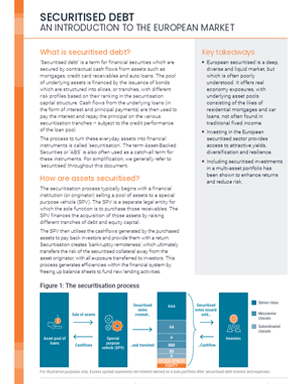Understanding Asset-Backed Securities (ABS)
For many investors, ABS can be an alternative to other debt instruments like investment-grade corporate bonds. While corporate bonds are an important component of a fixed income portfolio, the addition of ABS may help improve risk-adjusted returns due to their attractive yields, high credit quality, inherently low duration, and low correlation to equities.
Explore our ABS through Janus Henderson:
For investors seeking a steady stream of high income with lower risk than a dedicated high-yield strategy.
A high quality, conservatively managed fixed income solution aiming to provide downside resilience over cycles
The value of an investment and the income from it may go down as well as up and you may loose the amount originally invested.
Key characteristics of ABS
1
Attractive yields
Short weighted average life (WAL) of auto ABS is due to the shorter terms of the underlying loans. A lower WAL can enable investors to reduce portfolio sensitivity to moves in credit spreads.
Rapid de-leveraging is enabled by these short terms and deal structures, which can lead to significantly increased credit enhancement and facilitate roll down of the often sequential notes.
Diverse collateral from a broad range of issuers across a range of credit profiles, products and jurisdictions, with full capital strictures from AAA to sub-IG.
2
Exposure to consumer lending
In contrast to many other fixed income assets, ABS provide access to the vast U.S. consumer lending market. While U.S. Treasuries and corporate bonds give investors exposure to the U.S. government and to corporate issuers, respectively, ABS offer investors access to a broad range of consumer and commercial loans, or cash flow streams.
3
Strong credit ratings
Due in part to the various credit-enhancement provisions within their structure, over 85% of the European ABS market is investment grade, with 54% of the market carrying a AAA rating.
Default rates for ABS have historically compared favorably to investment-grade corporate credit: From the late 1990s through June 2024, no AAA ABS has defaulted, while 2002 was the only year in which the AA bucket experienced a default.
Source: JP Morgan International Securitisation Research as at 31/12/24
4
Generally low interest-rate sensitivity
ABS has generally exhibited lower duration than many other fixed income sectors, making them less sensitive to changes in interest rates.
Past performance does not predict future returns.
5
Historical low correlation to equities
ABS have historically exhibited low correlation to equities, potentially making them a good diversifier for multi-asset portfolios.
The importance of active management when investing in ABS
ABS cover a broad universe of subsectors that each have distinct fundamental and technical characteristics and that may perform differently through the market cycle. Therefore, investing in ABS requires specialised skill and experience to analyze each asset’s investment case and determine how it might perform under varying economic scenarios.
The value of an investment and the income from it may go down as well as up and you may lose the amount originally invested.

